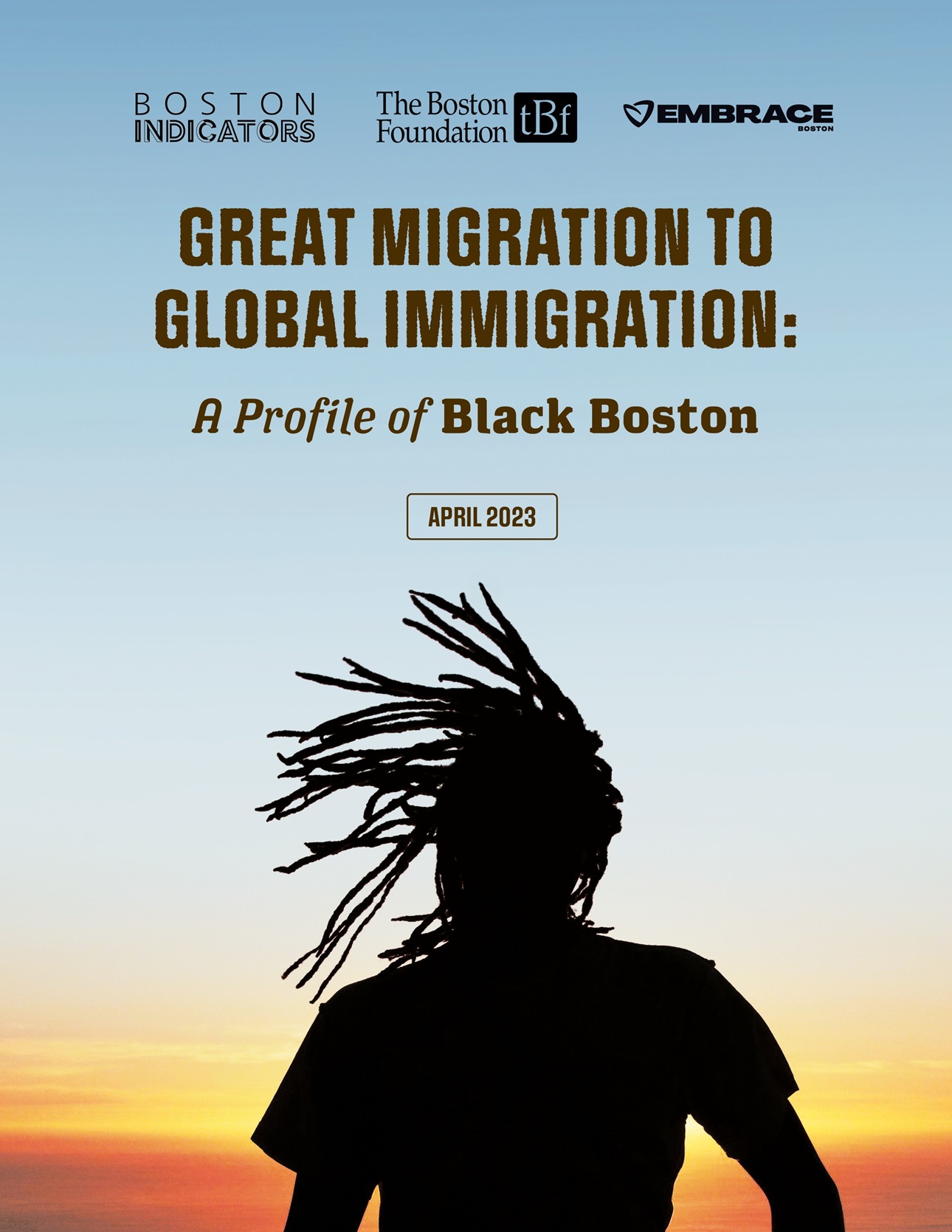Boston Indicators: Greater Boston Black Population Growing Larger and More Diverse, Especially Outside of Boston
Boston metro has largest foreign-born Black population share of any large metro area in the U.S.
April 6, 2023
Boston—A new analysis of Greater Boston’s Black population from Boston Indicators finds the number of people identifying as Black continues to grow steadily, especially in cities and towns south of Boston. The growth, driven in recent years by larger numbers of foreign-born Black people coming to the region, has moved Boston from the 20th to 17th largest Black population in the country, with the distinction of having the highest foreign-born Black population share of any large metropolitan area.
The report, entitled Great Migration to Global Immigration: A Profile of Black Boston, tracks the demographic history of Boston’s Black community as it has evolved and grown over the past century, and explores the continuing socioeconomic disparities between Black people and other racial groups, as well as between Black subpopulations. It was produced in partnership with Embrace Boston, and was prepared by Luc Schuster and Peter Ciurczak of Boston Indicators along with James Jennings, Ph.D., professor emeritus of Urban & Environmental Policy & Planning at Tufts University.
“This report celebrates Greater Boston’s uniquely diverse Black population –– one that includes multi-generational Black Americans as well as a range of more recent arrivals to the region from the Caribbean, Central America and Africa,” said M. Lee Pelton, President and CEO of the Boston Foundation. “While we celebrate that growing diversity and geographic spread, particularly south of Boston, we must still recognize, as this report does, the continuing impact of decades of structural and systemic racism that keeps long-time and newer Black residents from full equity in our communities.”
Growth – and Growing Diversity - in Greater Boston’s Black Community
The report finds Greater Boston’s Black population growth over the last 40 years is underpinned by two trends: a significant uptick in the number of Black people who identify as multiracial and multi-ethnic Black and Afro-Latino residents (primarily Afro-Dominican or Afro- Puerto Rican) and the movement of middle-class Black families to areas south of the city. In fact, four of the five communities in Greater Boston with the highest shares of Black population are south of Boston, led by Brockton, the only majority Black community in the region.
As the region’s Black population grows and moves, especially outside of Boston, it is also becoming among the most diverse in the nation. Dr. Jennings analyzed the ancestries of the region’s Black population, and highlighted six subgroups, including multigenerational Black Americans, a diverse array of foreign-born Black populations, an increasingly large and more visible group of Afro-Latino/as, a West Indian community of Black Haitians, Jamaicans and others, a historically significant Cape Verdean population, and a new and rapidly-growing population of African-born immigrants, many of whom are arriving as adults and settling in communities outside of the city. In sum, more than one-in-three metro Boston Black residents are foreign-born – the highest percentage in any major U.S. metropolitan area.
“The rise in the region’s foreign-born Black population and the rapid increase in the number of individuals identifying as Afro-Latino should refocus the way that we think about the Black population of Greater Boston,” said Jennings. “It is a community that is notably diverse in ancestry, ethnicity and geography, and we must account for that diversity in policy decisions moving forward.”
Socioeconomic differences evident – even between Black subgroups
While the recent growth and diverse strengthening of the region’s Black population is notable, it alone has not reversed Boston’s well-reported gaps on many socioeconomic indicators. The report tracks notable differences in income, wealth, business ownership and homeownership among Black, White, Asian and Latino/a individuals. On business ownership, for example, Black business owners make up less than 2 percent of all businesses with one or more employees, well below the overall Black share of the population.
The report also explores differences across many of these metrics between Black communities, finding substantial differences among Black subgroups in education, wealth and homeownership as well.
The report ends with several concluding questions that have implications for public policy, civic involvement, and strategies aimed at eliminating long-time racial inequalities. Those questions call for more responsible reporting and data around Black demographics and issues important to Black communities. In addition, they encourage the use of this data to inform discussions on Black reparations, and in talks on how best to embrace and celebrate the assets, resources, histories and cultures associated with Black experience.
“If we are to embrace a new vision for a radically inclusive and equitable Boston, that vision should include a recognition that there is no single Black experience or renaissance, but rather a spectrum of experiences, assets and resources that together shape who we are,” said Imari Paris Jeffries, Executive Director of Embrace Boston. “This report illustrates the work to be done, but more importantly, it illuminates the collective energy we bring to our efforts to transform the city and region.”

